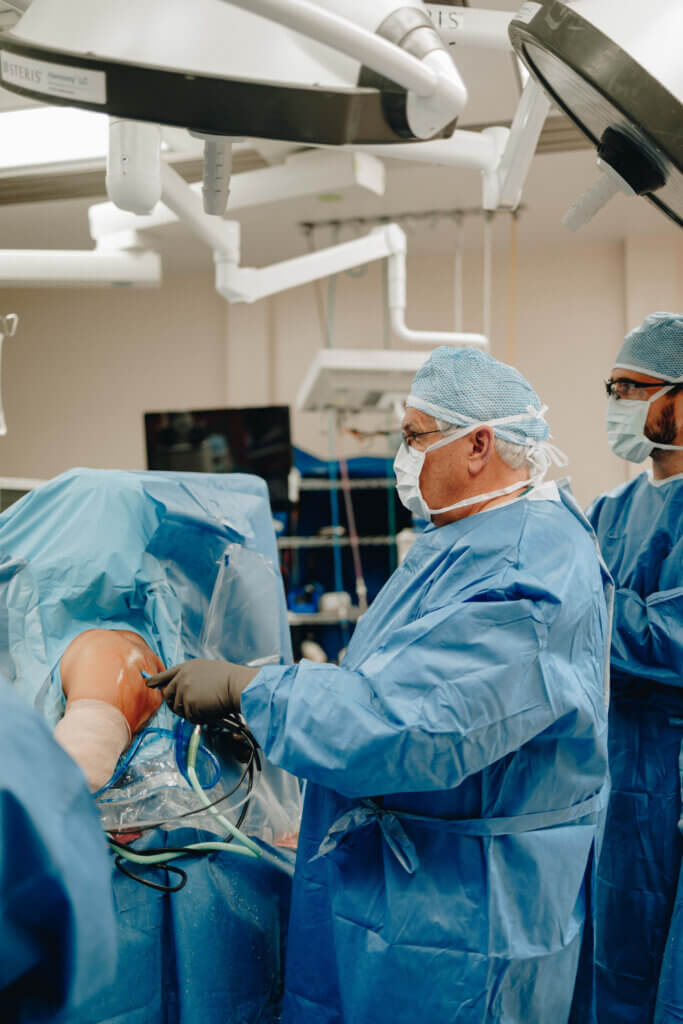
Knee surgery can be a great way to relieve pain and improve function in your knee. There are many different types of knee surgery, so it is important to schedule a consultation with Dr. Heckman to discuss which type of surgery is right for you. Recovery from knee surgery can take several weeks, so it is important to be prepared for the time commitment involved.
Total Knee Replacement versus Knee Arthroscopy
There are a few key things to consider when deciding whether or not you are a candidate for arthroscopy or knee surgery and the type of surgery that would be indicated. First, what is the underlying issue that needs to be treated? If you have advanced osteoarthritis, damage from a previous injury, or another degenerative condition, and have failed conservative management, then total knee replacement may be an option. However, if you have a torn ACL or meniscus or other more localized cartilage injury, arthroscopic surgery may be able to repair the damage and relieve your pain.
Second, how severe is your condition? Total knee replacements are generally reserved for patients with advanced degenerative conditions who have not found relief from conservative treatments such as medication, physical therapy, and weight loss. Arthroscopic surgery is a less invasive procedure that can be performed on patients presenting with injuries to the knee but is typically not used to treat more advanced arthritis.
Dr. Heckman will go over the different options available to you, as well as the risks and benefits of each treatment, so that you can make a decision that is right for your needs and goals.

There are several different types of knee surgeries that can be performed depending on the condition being treated. Some common examples include:
Knee Replacement Surgery
There are different types of knee replacement surgery depending on the extent of damage to your knee. If you have a very damaged knee, you may need what is called a total knee replacement, where the entire joint is replaced.
If you have less damage, you may be a candidate for a partial knee replacement, where only part of the joint is replaced. There are also different types of implants that can be used in knee replacement surgery, so Dr. Heckman will discuss all your options with you to find the best solution for your particular case.
Total Knee Replacement
Total knee replacement surgery is a procedure whereby the damaged joint surfaces of the knee are removed and replaced with artificial implants. This surgery is typically recommended for patients with advanced degenerative conditions who have not found relief from conservative treatments. Total knee replacement can relieve pain and restore range of motion, but it is a major surgery with risks and potential complications. Dr. Heckman typically uses computer navigation or the ROSA robot to assist when performing knee replacement surgery.
Arthroscopic Knee Surgery
Arthroscopic surgery is a minimally invasive surgical technique. It is performed with the assistance of a camera, arthroscope, and specialized equipment through small incisions. Arthroscopy is commonly performed to treat injuries of the knee, shoulder, hip, and elbow.
The technique improves surgical results and shortens the recovery time after surgery by minimizing injury to the joint and tissues. Procedures performed arthroscopically result in less post-operative scarring and pain.
Dr. Heckman specializes in knee and shoulder surgery and arthroscopic knee and shoulder procedures. He routinely performs knee arthroscopies using a “two portal technique” under local anesthesia and IV sedation. This allows his patients to avoid a general anesthetic and to rehabilitate more rapidly.
Meniscus Surgery
Meniscus surgery is a procedure that is performed to repair or remove damaged portions of the meniscus, a crescent-shaped piece of cartilage in the knee that serves as a shock absorber between the bones. This type of surgery may be necessary if you have sustained an injury resulting in a torn meniscus, or if degenerative changes have occurred causing the meniscus to tear with age.
There are two main types of meniscus surgery: meniscus repair and partial meniscus removal (meniscectomy). Torn meniscus surgery is performed using arthroscopic techniques, which involve inserting a small camera into the knee joint through a small incision to visualize the area to be repaired or removed.
The decision of whether to repair or remove the damaged portion of the meniscus will be based on the patient’s age, pre-existing arthritis and the location and type of the meniscal tear. The options and expectations for both will be discussed at your consultation with Dr. Heckman.


Knee Replacement Recovery Time
Recovery from knee replacement surgery usually takes 4 to 6 weeks. During this time, you will need to use crutches or a walker to protect your knee. You will also need to do physical therapy exercises to regain strength and range of motion in your knee.
As you progress through physical therapy during the first 6 weeks, you should expect to transition from crutches to a cane, to walking without aids. After about 6 weeks, you should be able to walk independently and bear full weight on your knee
It typically takes between 6 and 12 months for a knee replacement to fully heal. During this time, it’s important to continue with your prescribed exercise program and to stay active to promote a full recovery.